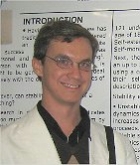The Ghost in the System: Where Free Will Lurks in Human Minds
Because the specific mechanisms in service of the attractor operate outside of awareness, the person feels as if some global property of mind—his or her insight, perhaps, or conscious will—is the source of moment-to-moment thoughts and feelings. Of course, the person can introspect on the nature of his or her thought process, but doing so transforms the stream of thought, with the person’s focus shifting to the mechanisms of thought rather than their products. Such introspection, moreover, requires another set of mechanisms which are implicit in their operation. The person can then reflect on those mechanisms, but this again transforms the stream of thought and involves yet other tacit mechanisms, and so on, in an infinite regress that is as productive as chasing one’s own shadow. In short, the processes responsible for constraining the flow of thought in service of an attractor are tacit in their operation—people look through these processes, not at them. Because attractor dynamics are invisible during their expression, people feel as though they are directing the show and can willfully change course at any time.
Thought and behavior are not always in service of attractor dynamics, however. In an unfamiliar situation or when considering novel action alternatives, for example, the person may lack a coherent higher-order state that constrains the flow of consciousness (cf. Vallacher & Wegner, 1987). In the absence of an attractor, the person’s trajectory of thought and behavior follows one of two scenarios. On one hand, it may be under the control of the social or physical context surrounding the actor. This scenario reflects the “power of the situation” mantra that permeates certain quarters of social psychology. Sometimes, however, the context provides weak or conflicting guides for mind and action. In this case, the person’s thoughts and behaviors are unconstrained, capable of taking off in very different directions depending on slight variations in initial conditions (e.g., a trivial feature of the situation, a random thought, or a spontaneous lower-level action).
This latter scenario comes very close to capturing the true essence of free will. (Interestingly, a system that is not constrained by an attractor is said to have many “degrees of freedom.”) But this is not the type of free will that people find desirable (cf. Dennett, 1985). To navigate the demands and choices of social life, people need a frame of reference that provides a coherent and stable platform for decision-making and action. Having a surplus of choices can undermine a person’s sense of control, promoting a corresponding decrement in his or her feeling of free will. Harvey and Jellison (1974), for example, found that people had a greater sense of personal freedom and control when they could choose from six as opposed to twelve alternatives. Too much freedom of choice—or conversely, too little constraint—can be aversive, reducing a person’s freedom to a sense of uncertainty and indecision. Faced with this prospect, people look for and embrace cues to higher-order meaning that provide a coherent framework for thought and action—even if this means adopting the perspective of influence agents and authority figures (Vallacher & Wegner, 1987). In effect, the lack of constraints on moment-to-moment dynamics promotes what existentialist philosophers call an “escape from freedom” (e.g., Fromm, 1941).


